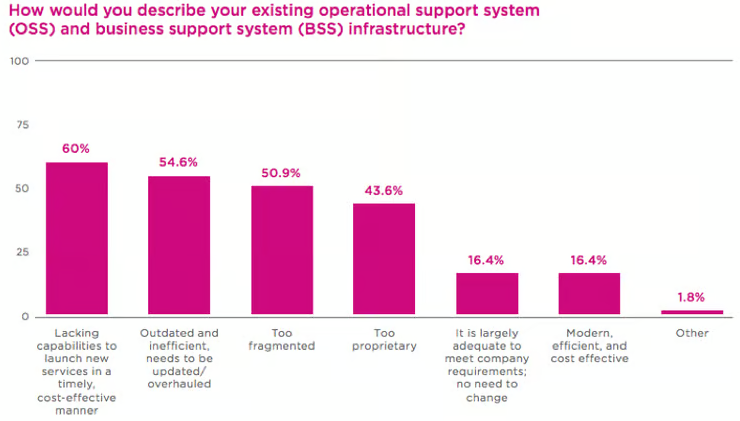Imagine you’re trying to manage a city – a vast, bustling metropolis with countless activities happening all at once. This is what telecom companies face every day, managing millions of data points and connections. Here’s where OSS architecture in telecom steps in. It’s like the central command center that helps telecom giants navigate and manage this intricate web of activities.
Now, let’s break down some stats to grasp the scale here. By the end of 2023, the global telecom market is expected to surpass $1.4 trillion. That’s a staggering number! In this enormous market, OSS architecture in telecom plays a critical role, almost like the unsung hero in the background.
Did you know?
A study found that implementing advanced OSS systems could reduce operational costs by up to 25% for telecom operators. (Source: Telecom Analyst Group)
OSS architecture in telecom is like a complex puzzle, with pieces that include network inventory, service management, fault management and more. Each piece is vital. For instance, network inventory manages resources like bandwidth and routing paths. Think of it as the city planner, ensuring that every street and building is in the right place. Then there’s service management. This is like the customer service of our city, ensuring that every citizen (or in this case, user) gets the service they need, whether it’s a simple phone call or high-speed internet.
And we can’t forget fault management. This is the emergency response team, always ready to jump in when something goes wrong, like a dropped call or network outage. It’s all about quick and efficient problem-solving.
Read also: How Forward-Thinking Telcos Are Delivering Sustained Customer Experience
But why does all this matter? Well, with the ever-increasing demand for faster, more reliable communication, OSS architecture in telecom is the backbone that keeps the industry standing tall. It’s what enables us to enjoy seamless video calls from across the globe or stream our favorite shows without a hitch.
OSS in telecom is more than just technical jargon. It’s a vital part of the global connectivity, constantly working behind the scenes to ensure that telco operations run smoothly. So the next time you make a call or send a message, remember there’s a whole world of OSS architecture in telecom making it all possible!
What is OSS Architecture in Telecom?
Operational Support Systems (OSS) are specialized software and hardware configurations used by telecommunications service providers.
Key Components of OSS Architecture
- Network Management Systems (NMS): These OSS systems in telecom monitor and control telecom networks, ensuring optimal performance and reliability.
- Service Delivery Platforms: They facilitate the deployment of services, managing the lifecycle of service provisioning and activation.
- Workforce Management Systems: These systems manage the scheduling and deployment of field service personnel.
- Inventory Management Systems: They keep track of network resources, including physical and virtual assets.
- Customer Support Systems: These OSS systems in telecom handle customer interactions, including service requests and troubleshooting.
- Fault Management Systems: These systems are designed to detect, isolate, and correct faults in the telecom network. They are crucial for maintaining high levels of network availability and reliability.
- Performance Management Systems: These systems monitor and analyze the performance of network elements and services. They help in optimizing network efficiency and ensuring quality of service (QoS) standards are met.
- Configuration Management Systems: Responsible for managing network configurations, these systems ensure that all network devices and services are correctly set up and modified as required.
- Order Management Systems: These OSS systems in telecom manage the lifecycle of customer orders, from initial order capture to fulfillment. They are essential for ensuring timely and accurate service delivery to customers.
- Billing and Revenue Management Systems: These OSS systems in telecom handle billing, charging, and accounting for telecom services. They are crucial for revenue assurance and for providing customers with accurate billing information.
Read also: The Crucial Role of OSS in Telecom for Billing Operations
- Service Assurance Systems: These systems are focused on ensuring that all telecom services are delivered at the promised quality levels. They encompass various functions like service monitoring, problem management, and customer experience management.
- Security Management Systems: Given the critical nature of telecom networks, these OSS systems are dedicated to protecting the network and its data from unauthorized access, cyber threats, and other security risks.
- Business Intelligence and Analytics Systems: These systems analyze data from various OSS components to provide insights for decision-making, trend analysis, and strategic planning.
- Provisioning Systems: These are responsible for the setup and management of services for customers, including activation, modification, and deactivation of services as per customer requirements.
The Role of OSS in Telecom Operations
OSS architecture in telecom plays a critical role:
- Efficiency in Network Management: OSS tools automate many aspects of network management, reducing the need for manual intervention and increasing operational efficiency.
- Enhanced Service Delivery: By streamlining service provisioning and management, OSS architecture in telecom ensures that customers receive reliable and high-quality services.
- Real-Time Data Analysis: OSS systems provide real-time insights into network performance, helping in proactive maintenance and reducing downtime.
- Cost Reduction: Automation and efficient resource management lead to significant cost savings for telecom operators.
- Improved Customer Experience: OSS systems in telecom play a crucial role in monitoring and managing customer service quality. By quickly identifying and resolving issues, these systems help in maintaining high levels of customer satisfaction.
- Regulatory Compliance: OSS helps telecom operators comply with various regulatory requirements by maintaining accurate records, ensuring transparent operations, and providing necessary reports and documentation.
- Scalability and Flexibility: As telecom operators grow and evolve, OSS systems provide the scalability and flexibility needed to manage expanding networks and customer bases effectively.
- Enhanced Security and Risk Management: With the increasing threat of cyber-attacks, OSS systems in telecom are essential for monitoring network security, identifying potential threats, and implementing preventive measures.
- Integration with Business Support Systems (BSS): OSS works in conjunction with BSS to provide a comprehensive view of both operational and business aspects, enabling better decision-making and strategy formulation.
Read also: The AI Effect – How Telcos Are Winning with OSS/BSS Intelligence
- Disaster Recovery and Business Continuity: OSS architecture in telecom include mechanisms for disaster recovery and business continuity, ensuring that telecom services can be maintained or quickly restored in the event of major disruptions.
- Resource Optimization: By providing detailed insights into network utilization and performance, OSS helps in optimizing the allocation and use of resources, thereby reducing wastage and improving overall efficiency.
- Future-Proofing the Network: OSS systems facilitate the adoption of new technologies like 5G, IoT, Edge and Cloud services, ensuring that telecom networks are future-ready.
- Streamlining Vendor Management: OSS architecture in telecom helps to manage multiple vendor relationships, ensuring seamless integration of different systems and technologies within the network.
- Environmental Sustainability: By optimizing network efficiency and resource utilization, OSS in telecom can contribute to the environmental sustainability goals of telecom operators, reducing energy consumption and the carbon footprint of network operations.
Did you know?
OSS-driven analytics can help to identify and resolve network issues proactively, improving customer satisfaction scores by 15%.
Simplifying Complex Operations

Telecom operations are inherently complex, involving vast networks and numerous services. OSS architecture simplifies these operations by:
- Automating Routine Tasks: Reducing manual errors and increasing operational speed.
- Centralizing Control: Offering a unified view of the network, simplifying management.
- Facilitating Rapid Service Deployment: Enabling telecom operators to quickly launch and scale new services.
- Advanced Data Analytics: With the increasing amount of data generated by modern telecom networks, OSS systems help to employ advanced data analytics to gain deeper insights into network performance, customer behavior, and market trends.
- Network Function Virtualization (NFV) and Software-Defined Networking (SDN): OSS plays a key role in managing and orchestrating virtualized network functions and software-defined networks, leading to more agile and flexible network management.
- IoT Integration: As the number of connected IoT devices grows exponentially, OSS architecture in telecom efficiently manages these devices and the data they generate, ensuring seamless connectivity and service delivery.
- Blockchain Integration: Potential integration of blockchain technology for enhanced security, transparency, and efficiency in operations like billing, roaming agreements, and identity management.
- Edge Computing Support: OSS will manage and orchestrate services at the network edge, catering to low-latency and high-bandwidth applications like AR/VR and autonomous vehicles.
- Cross-Domain Orchestration: OSS will evolve to manage not just telecom networks but also cross-domain services involving IT and cloud resources, creating a more holistic service environment.
Future of OSS Architecture in Telecom
As the telecom industry evolves and adapts new-age technologies like AI, 5G, IoT, and Edge/Cloud computing, OSS architecture in telecom is also evolving.
Future trends include:
- Integration with Cloud Services: Enhancing scalability and flexibility of network operations.
- AI and Machine Learning: For predictive maintenance and improved decision-making. Automation of routine tasks, personalized marketing campaigns, and enhanced customer experience.
- Enhanced Customer Experience Management: Leveraging OSS data to personalize and improve customer service.
Did you know?
Telcos using OSS to deploy 5G networks can reduce time-to-market by 30%.
- Digital Twins: Utilizing digital twins in OSS for telecom for creating virtual models of physical network components. This allows for more effective simulation, analysis, and optimization of network operations.
- Zero-Touch Automation: Implementing more sophisticated automation technologies to enable zero-touch provisioning, configuration, and management of network services and components, reducing human intervention to a minimum.
- Sustainable Network Operations: Emphasizing eco-friendly practices in OSS to optimize energy consumption, reduce carbon footprint, and promote sustainable network operations.
- Advanced Network Slicing Management: Leveraging network slicing more effectively in OSS to provide customized connectivity solutions for different types of services and users, especially relevant for 5G networks.
- Interoperability and Open Standards: Focusing on interoperability between different OSS solutions and adherence to open standards to facilitate smoother integration and collaboration across various vendors and platforms.
Takeaway
OSS architecture in telecom is the unsung hero of the industry, playing a vital role in ensuring efficient and reliable network operations. As technology advances, the role of OSS architecture in telecom will become even more integral in managing the complexities of modern telecom networks.
In the rapidly evolving world of telecommunications, staying ahead means embracing the latest technologies and strategies. OSS architecture in telecom is not just a part of the industry; it’s the backbone that supports and drives it.
Are you ready to dive deeper and harness the full potential of OSS in your telecom operations?
Get in touch with our telco OSS expert today to join the revolution.



